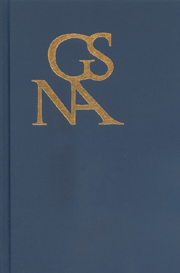Book contents
- Frontmatter
- Contents
- Presidential Address (December, 2004) Schiller vs. Goethe: Revisiting the Conflicting Reception Vectors of Heinrich Heine, Ludwig Börne, and Wolfgang Menzel
- Goethe's Mixed Media: The Entertainers in Jahrmarktsfest zu Plundersweilern
- Goethe's “Ilmenau” and the Origins of the Aesthetic State
- Familial Politics and Political Families: Consent, Critique, and the Fraternal Social Contract in Schiller's Die Räuber
- Paintings in Goethe's Wilhelm Meister Novels: The Dynamics of Erecting and “Eroding” the Paternal Law
- “Waldplatz,” “Wahlplatz”: Miszelle zur Golgatha-Konnotation einer Episode in Wilhelm Meisters Lehrjahre
- Shocks from a Sicilian Underworld: Gangi,“Gänge,” and a New Source for the “Mütter” in Goethe's Faust
- “Feuer brennen blau”: Rethinking the Rainbow in Goethe's Faust
- Cosmopolitanism and Weltliteratur
- “Von jedem öffentlichen Wirken in Deutschland ausgeschloßen”: Ein Brief Ottilie von Goethes an Sarah Austin (4. Aug. 1840)
- Book Reviews
“Feuer brennen blau”: Rethinking the Rainbow in Goethe's Faust
Published online by Cambridge University Press: 05 February 2013
- Frontmatter
- Contents
- Presidential Address (December, 2004) Schiller vs. Goethe: Revisiting the Conflicting Reception Vectors of Heinrich Heine, Ludwig Börne, and Wolfgang Menzel
- Goethe's Mixed Media: The Entertainers in Jahrmarktsfest zu Plundersweilern
- Goethe's “Ilmenau” and the Origins of the Aesthetic State
- Familial Politics and Political Families: Consent, Critique, and the Fraternal Social Contract in Schiller's Die Räuber
- Paintings in Goethe's Wilhelm Meister Novels: The Dynamics of Erecting and “Eroding” the Paternal Law
- “Waldplatz,” “Wahlplatz”: Miszelle zur Golgatha-Konnotation einer Episode in Wilhelm Meisters Lehrjahre
- Shocks from a Sicilian Underworld: Gangi,“Gänge,” and a New Source for the “Mütter” in Goethe's Faust
- “Feuer brennen blau”: Rethinking the Rainbow in Goethe's Faust
- Cosmopolitanism and Weltliteratur
- “Von jedem öffentlichen Wirken in Deutschland ausgeschloßen”: Ein Brief Ottilie von Goethes an Sarah Austin (4. Aug. 1840)
- Book Reviews
Summary
COLOR AS NATURAL PHENOMENON and carrier of symbolic meaning fascinated Goethe from early on—both the effects of individual colors, as well as their relationships to one another as part of a system. But while the rainbow holds a central place in Goethe scholarship, the broader topic of the significance of colors in Faust has received remarkably little attention. The starting point of this investigation, therefore, is the shift from red flames to blue in the prologue to the Classical Walpurgisnacht. This shift poses a question about colors that has far reaching consequences for Faust.
Erichtho's introduction begins with sinister red watch fires and the specter of spilt blood, but with the rise of the moon the violent images vanish and the red flames burn blue:
Wachfeuer glühen, rote Flammen spendende,
Der Boden haucht vergoßnen Blutes Widerschein,
Und angelockt von seltnem Wunderglanz der Nacht,
Versammelt sich hellenischer Sage Legion.
Um alle Feuer schwankt unsicher oder sitzt
Behaglich alter Tage fabelhaft Gebild …
Der Mond, zwar unvollkommen, aber leuchtend hell,
Erhebt sich, milden Glanz verbreitend überall;
Der Zelten Trug verschwindet, Feuer brennen blau. (7025–33)
Commentaries on Faust generally attribute these blue flames to the effects of the rising moon, often in terms of Goethe's scientific theories on optics. And yet Rupprecht Matthaei, a leading scholar of the Farbenlehre and author of the one systematic study of Goethe's use of color in Faust, observes that a Paralipomenon from 1830 describes first the change in color and then the rise of the moon.
- Type
- Chapter
- Information
- Goethe Yearbook 13 , pp. 149 - 164Publisher: Boydell & BrewerPrint publication year: 2005



